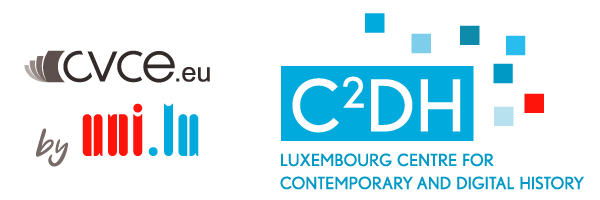June 1950: "Events that led to the United Kingdom’s absence from the negotiations on the Schuman Plan": note from Oliver Harvey, British Ambassador to Paris, to Kenneth Younger, Minister of State to the British Foreign Minister, Ernest Bevin https://shorturl.at/iCMPR #Schumanplan
@CVCEeu / 05/06/23 16:17Explore our thematic collections on the European integration process and an extensive range of sources, complete with context and background information.
Recent tweets
À l’occasion du 73e anniversaire de la déclaration Schuman, consultez notre dossier « Du plan Schuman au traité de Paris » https://urlz.fr/lLMb sur cvce.eu. (photos: (c)Union européenne - Caricature de Koob: le pool charbon-acier franco-allemand (c)Der Mittag)
CVCE @CVCEeu / 09/05/23 9:48#otd 8 mai 1945 – la fin des combats en Europe – dossier sur les conséquences humaines, économiques et politiques de la Seconde Guerre mondiale sur le continent https://urlz.fr/lLNL photo: Distribution de nourriture en Belgique au 1er janvier 1946 (c) United Nations Photos
CVCE @CVCEeu / 08/05/23 12:57Cartoon by Stig on the Saar question (March 1950) - ‘In the European forge.’ Illustrating postwar Franco-German issues #Saarland https://urlz.fr/lcgJ
CVCE @CVCEeu / 31/03/23 09:56Focus on the Schuman Declaration (9 May 1950)
- 1
- 2
 Historical events The ‘Historical events in the European integration process’ collection presents and analyses the milestones that shaped the European integration process from 1945 to 2009.
Historical events The ‘Historical events in the European integration process’ collection presents and analyses the milestones that shaped the European integration process from 1945 to 2009.  European organisations The ‘European organisations’ collection presents and analyses the development of the main international organisations involved in European integration that were set up in Western Europe from 1945 to 2009.
European organisations The ‘European organisations’ collection presents and analyses the development of the main international organisations involved in European integration that were set up in Western Europe from 1945 to 2009.  Specific topicsThese collections provide a detailed analysis of specific topics related to the European integration process.
Specific topicsThese collections provide a detailed analysis of specific topics related to the European integration process. 
 Oral history The ‘Oral history’ collection presents audio and video accounts from key players and observers of the European integration process.
Oral history The ‘Oral history’ collection presents audio and video accounts from key players and observers of the European integration process.
